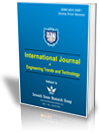A Comparative Analysis of Various Soft Computing Techniques for Indian Stock Market Prediction
A Comparative Analysis of Various Soft Computing Techniques for Indian Stock Market Prediction |
||
 |
 |
|
| © 2025 by IJETT Journal | ||
| Volume-73 Issue-3 |
||
| Year of Publication : 2025 | ||
| Author : Lavanya Balaji, Anita HB , Balaji Ashok Kumar |
||
| DOI : 10.14445/22315381/IJETT-V73I3P107 | ||
How to Cite?
Lavanya Balaji, Anita HB , Balaji Ashok Kumar, "A Comparative Analysis of Various Soft Computing Techniques for Indian Stock Market Prediction," International Journal of Engineering Trends and Technology, vol. 73, no. 3, pp. 95-103, 2025. Crossref, https://doi.org/10.14445/22315381/IJETT-V73I3P107
Abstract
Soft computing techniques have been increasingly used for stock market analysis in the past few years because they can capture nonlinear aspects which traditional econometric models do not adequately capture. With different techniques like Artificial Neural Networks, Deep Neural Networks and Stacked Autoencoders available, in this paper, the author tries to determine which of the above methods can model the Indian stock market with higher accuracy. In this study, high-frequency data from Nifty 50 is used, and various feature selection techniques such as PCA and linear regression are used for each of the above machine learning models to predict the Nifty 50 data. Finally, all predictions from the different techniques are compared with the actual index movement and the best method for Nifty 50 is suggested.
Keywords
Artificial Neural Network, Deep Neural Network, Nifty 50, Stock market, Principal Component Analysis (PCA).
References
[1] Dinesh Bajracharya, “Econometric Modeling Vs Artificial Neural Networks: A Sales Forecasting Comparison,” Master’s Thesis in Informatics, University of Borås, 2011.
[Google Scholar]
[2] Yoshua Bengio, “Learning Deep Architectures for AI,” Foundations and Trends® in Machine Learning, vol. 2, no. 1, pp. 1-127, 2009.
[CrossRef] [Google Scholar] [Publisher Link]
[3] Irving Biederman, “Recognition-by-Components: A Theory of Human Image Understanding,” Psychological Review, vol. 94, no. 2, pp. 115-147, 1987.
[Google Scholar] [Publisher Link]
[4] Yingxuan Chen, Weiwei Lin, and James Z. Wang, “A Dual-Attention-Based Stock Price Trend Prediction Model with Dual Features,” IEEE Access, vol. 7, pp. 148047-148058, 2019.
[CrossRef] [Google Scholar] [Publisher Link]
[5] B.S. Everitt, and A. Skrondal, The Cambridge Dictionary of Statistics, Cambridge University Press, pp. 1-168, 2010.
[Google Scholar] [Publisher Link]
[6] Eugene F. Fama, “Efficient Capital Markets: A Review of Theory and Empirical Work,” The Journal of Finance, vol. 25, no. 2, pp. 383-417, 1970.
[CrossRef] [Google Scholar] [Publisher Link]
[7] Rob Hyndman et al., “Forecast: Forecasting Functions for Time Series and Linear Models,” CRAN R-Project, 2021.
[CrossRef] [Publisher Link]
[8] Htet Htet Htun, Michael Biehl, and Nicolai Petkov, “Survey of Feature Selection and Extraction Techniques for Stock Market Prediction,” Finance Innovation, vol. 9, no. 1, pp. 1-25, 2023.
[CrossRef] [Google Scholar] [Publisher Link]
[9] A. Idri, T.M. Khoshgoftaar, and A. Abran, “Can Neural Networks be Easily Interpreted in Software Cost Estimation?,” IEEE World Congress on Computational Intelligence. 2002 IEEE International Conference on Fuzzy Systems. FUZZ-IEEE'02. Proceedings (Cat. No.02CH37291), Honolulu, HI, USA, vol. 2, pp. 1162-1167, 2002.
[CrossRef] [Google Scholar] [Publisher Link]
[10] George H. John, Ron Kohavi, and Karl Pfleger, “Irrelevant Features and the Subset Selection Problem,” Machine Learning Proceedings, pp. 121-129, 1994.
[CrossRef] [Google Scholar] [Publisher Link]
[11] Miroslav Kubat, An Introduction to Machine Learning, 2nd ed., Springer International Publishing, New York, pp. 1-348, 2017.
[CrossRef] [Google Scholar] [Publisher Link]
[12] Max Kuhn, “Building Predictive Models in R Using the caret Package,” Journal of Statistical Software, vol. 28, no. 5, pp. 1-26, 2008.
[CrossRef] [Google Scholar] [Publisher Link]
[13] Mahinda Mailagaha Kumbure et al., “Machine Learning Techniques and Data for Stock Market Forecasting: A Literature Review,” Expert Systems with Applications, vol. 197, pp. 1-41, 2022.
[CrossRef] [Google Scholar] [Publisher Link]
[14] Guifang Liu, Huaiqian Bao, and Baokun Han, “A Stacked Autoencoder-Based Deep Neural Network for Achieving Gearbox Fault Diagnosis,” Mathematical Problems in Engineering, vol. 2018, pp. 1-10, 2018.
[CrossRef] [Google Scholar] [Publisher Link]
[15] Robert Thomas Olszewski, “Generalized Feature Extraction for Structural Pattern Recognition in Time-Series Data,” Master’s Theses, Carnegie Mellon University, pp. 1-124, 2001.
[Google Scholar] [Publisher Link]
[16] Bernhard Pfaff, Analysis of Integrated and Cointegrated Time Series with R, Springer, New York, 2nd ed., pp. 1-190, 2008.
[CrossRef] [Google Scholar] [Publisher Link]
[17] Jinwen Sun et al., “Exploiting Intra-Day Patterns for Market Shock Prediction: A Machine Learning Approach,” Expert Systems with Applications, vol. 127, pp. 272-281, 2019.
[CrossRef] [Google Scholar] [Publisher Link]
[18] Ryan J. Urbanowicz et al, “Relief-Based Feature Selection: Introduction and Review,” Journal of Biomedical Informatics, vol. 85, pp. 189-203, 2018.
[CrossRef] [Google Scholar] [Publisher Link]
[19] Qing-Guo Wang, Xian Li, and Qin Qin, “Feature Selection for Time Series Modelling,” Journal of Intelligent Learning Systems and Applications, vol. 5, no. 3, pp. 152-164, 2013.
[CrossRef] [Google Scholar] [Publisher Link]
[20] Vidushi Tiwari et al., “Stock Market Prediction using Different Machine Learning Algorithms,” 10th IEEE Uttar Pradesh Section International Conference on Electrical, Electronics and Computer Engineering, Gautam Buddha Nagar, India, pp. 147-151, 2023.
[CrossRef] [Google Scholar] [Publisher Link]
[21] Kuldeep Agnihotri et al., “Next-Generation Stock Market Prediction: Integrating CNN and LSTM Model,” 2024 International Conference on Data Science and Network Security (ICDSNS), Tiptur, India, pp. 1-6, 2024.
[CrossRef] [Google Scholar] [Publisher Link]
[22] Chirag Rathi et al., “Time Series Forecasting for Stock Price Movement: Leveraging NLP for Stock Market Prediction,” Advances in Data and Information Sciences, vol. 1127, pp. 147-158, Springer, Singapore, 2025.
[CrossRef] [Google Scholar] [Publisher Link]
[23] Odeyemi Olubusola et al., “Machine Learning in Financial Forecasting: A US review: Exploring the Advancements, Challenges, and Implications of AI-Driven Predictions in Financial Markets,” World Journal of Advanced Research and Reviews, vol. 21, no. 2, pp. 1969-1984, 2024.
[CrossRef] [Google Scholar] [Publisher Link]
[24] Pushpendra Singh Sisodia et al., “Stock Market Analysis and Prediction for Nifty50 using LSTM Deep Learning Approach,” 2022 2nd International Conference on Innovative Practices in Technology and Management, Gautam Buddha Nagar, India, pp. 156-161, 2022.
[CrossRef] [Google Scholar] [Publisher Link]
[25] Manali Patel, Krupa Jariwala, and Chiranjoy Chattopadhyay, “An Approach toward Stock Market Prediction and Portfolio Optimization in Indian Financial Sectors,” IEEE Transactions on Computational Social Systems, vol. 12, no. 1, pp. 128-139, 2025.
[CrossRef] [Google Scholar] [Publisher Link]
[26] Bo Du et al., “Stacked Convolutional Denoising Auto-Encoders for Feature Representation,” IEEE Transactions on Cybernetics, vol. 47, no. 4, pp. 1017-1027, 2017.
[CrossRef] [Google Scholar] [Publisher Link]
[27] Junhua Zheng, Zeyu Yang, and Zhiqiang Ge, “Deep Residual Principal Component Analysis as Feature Engineering for Industrial Data Analytics,” IEEE Transactions on Instrumentation and Measurement, vol. 73, pp. 1-10, 2024.
[CrossRef] [Google Scholar] [Publisher Link]

